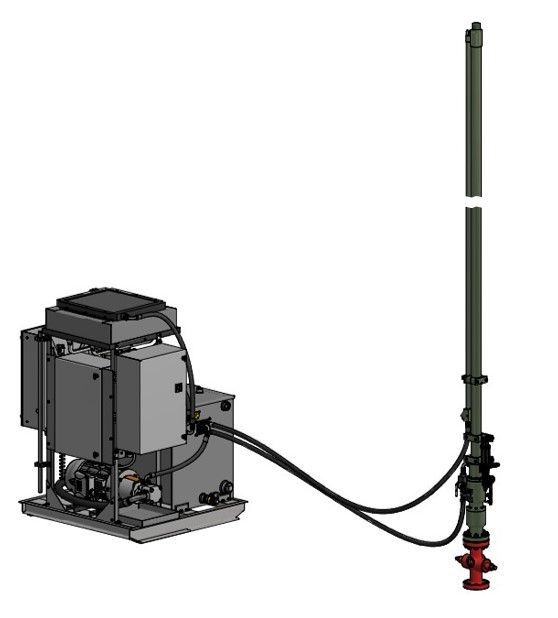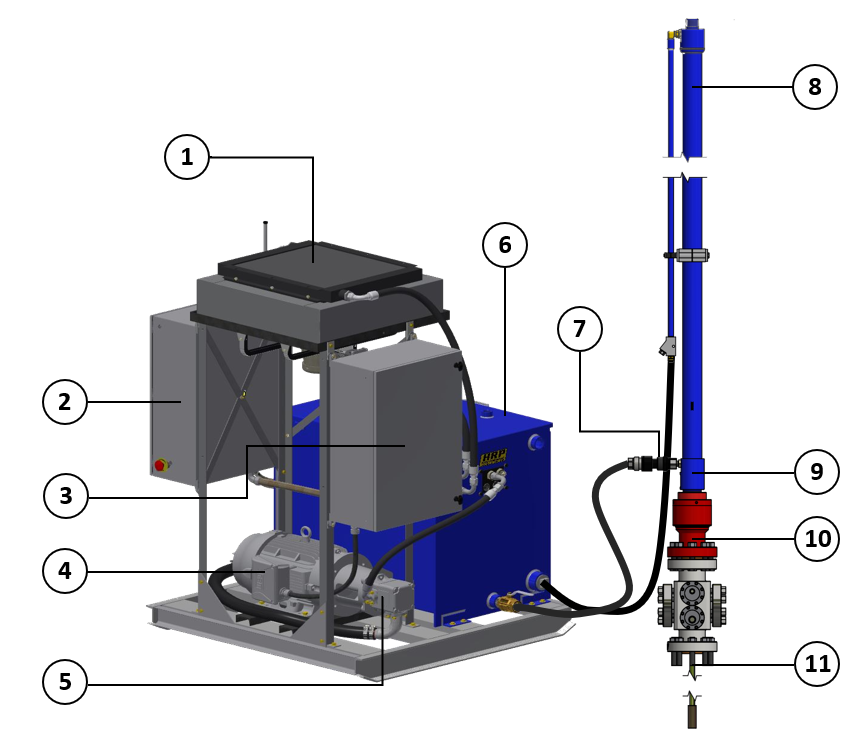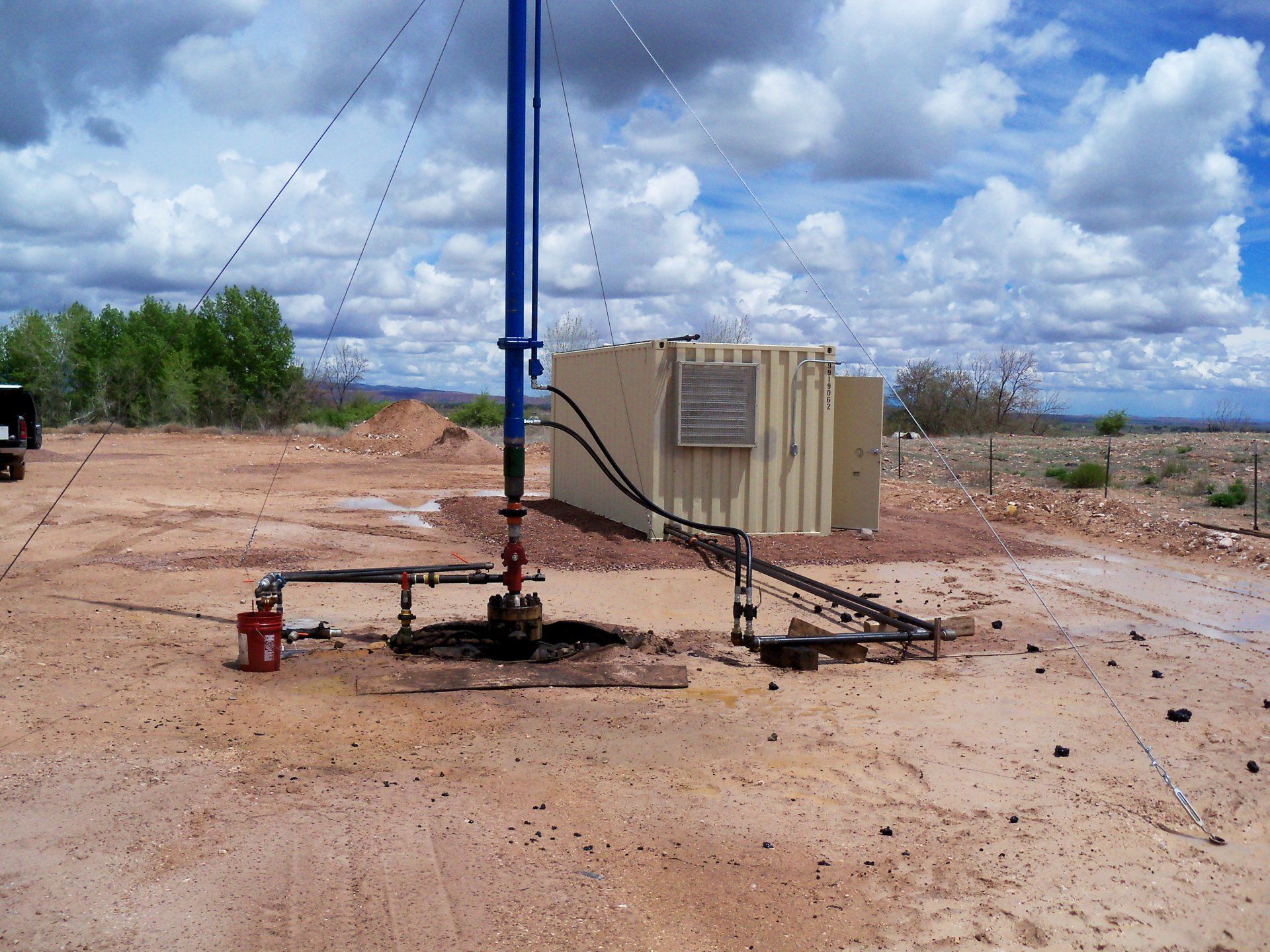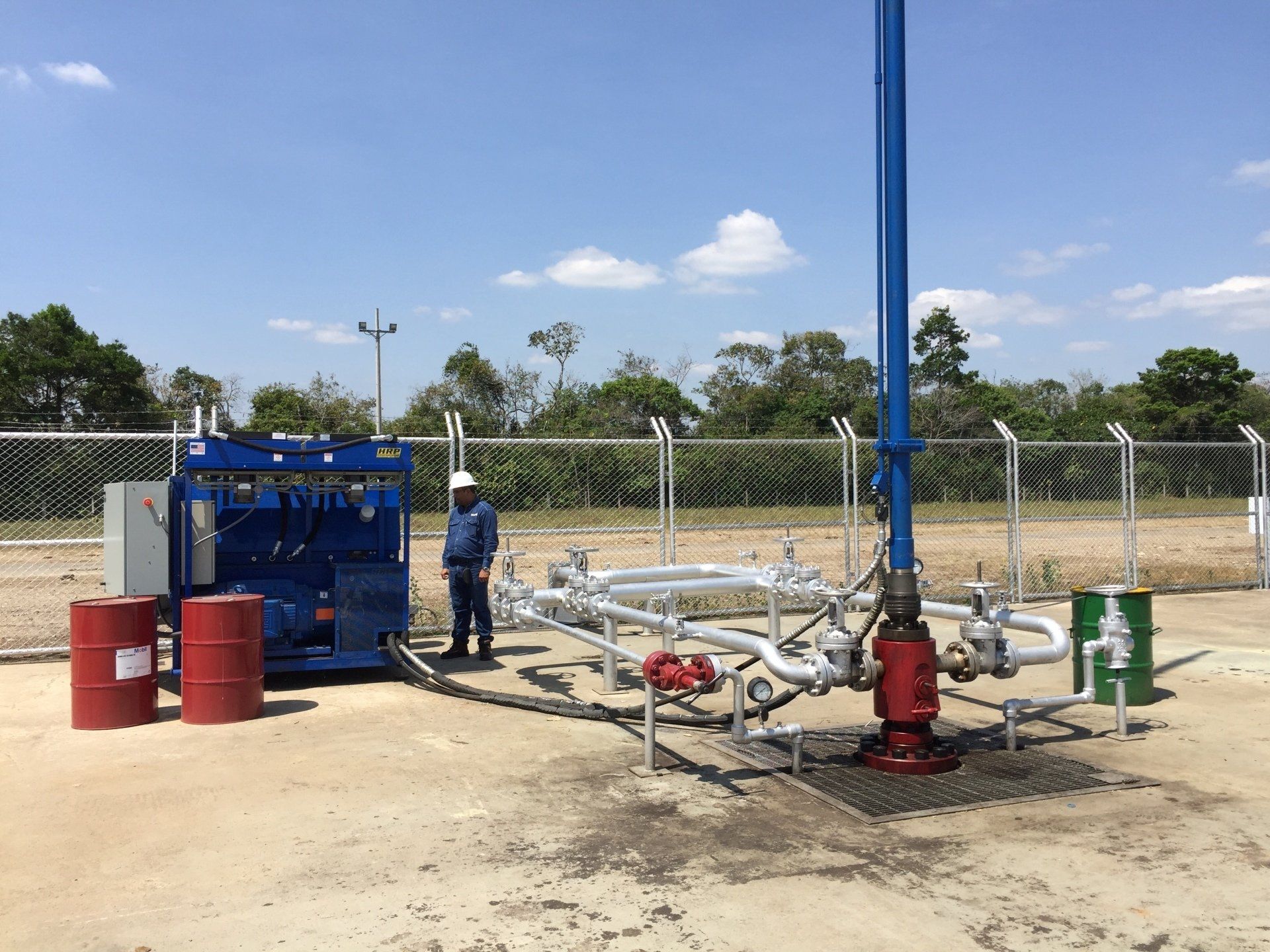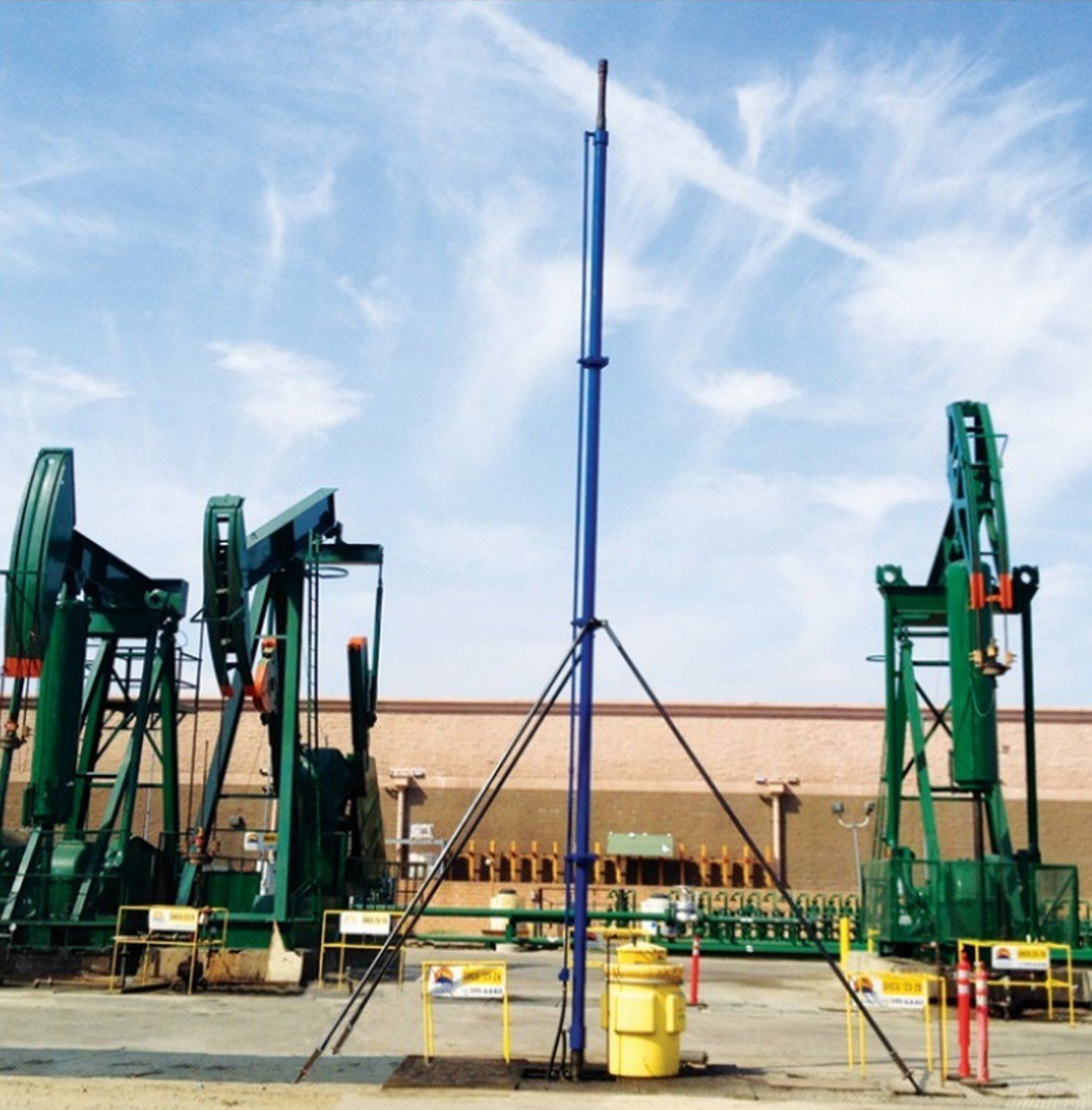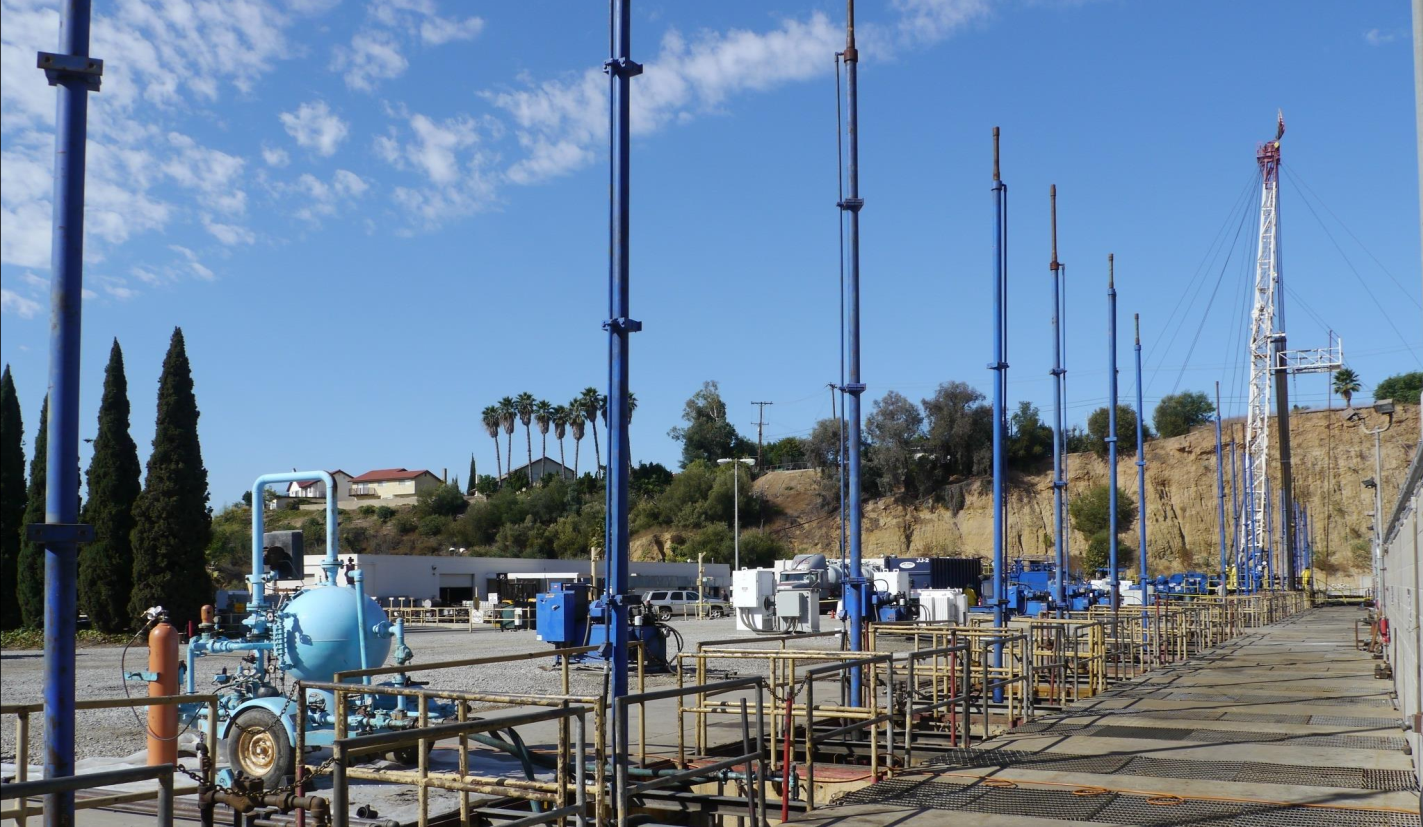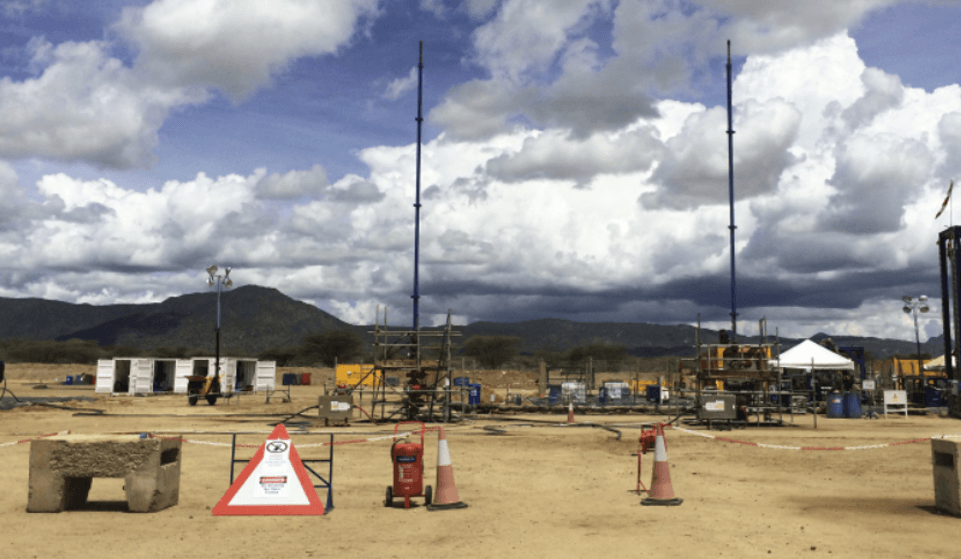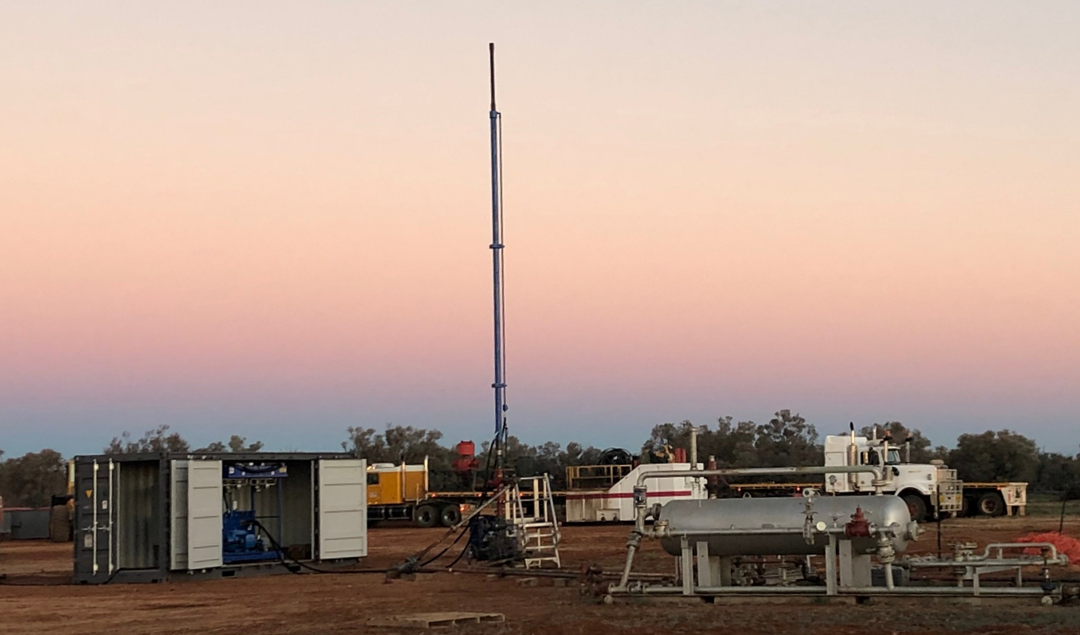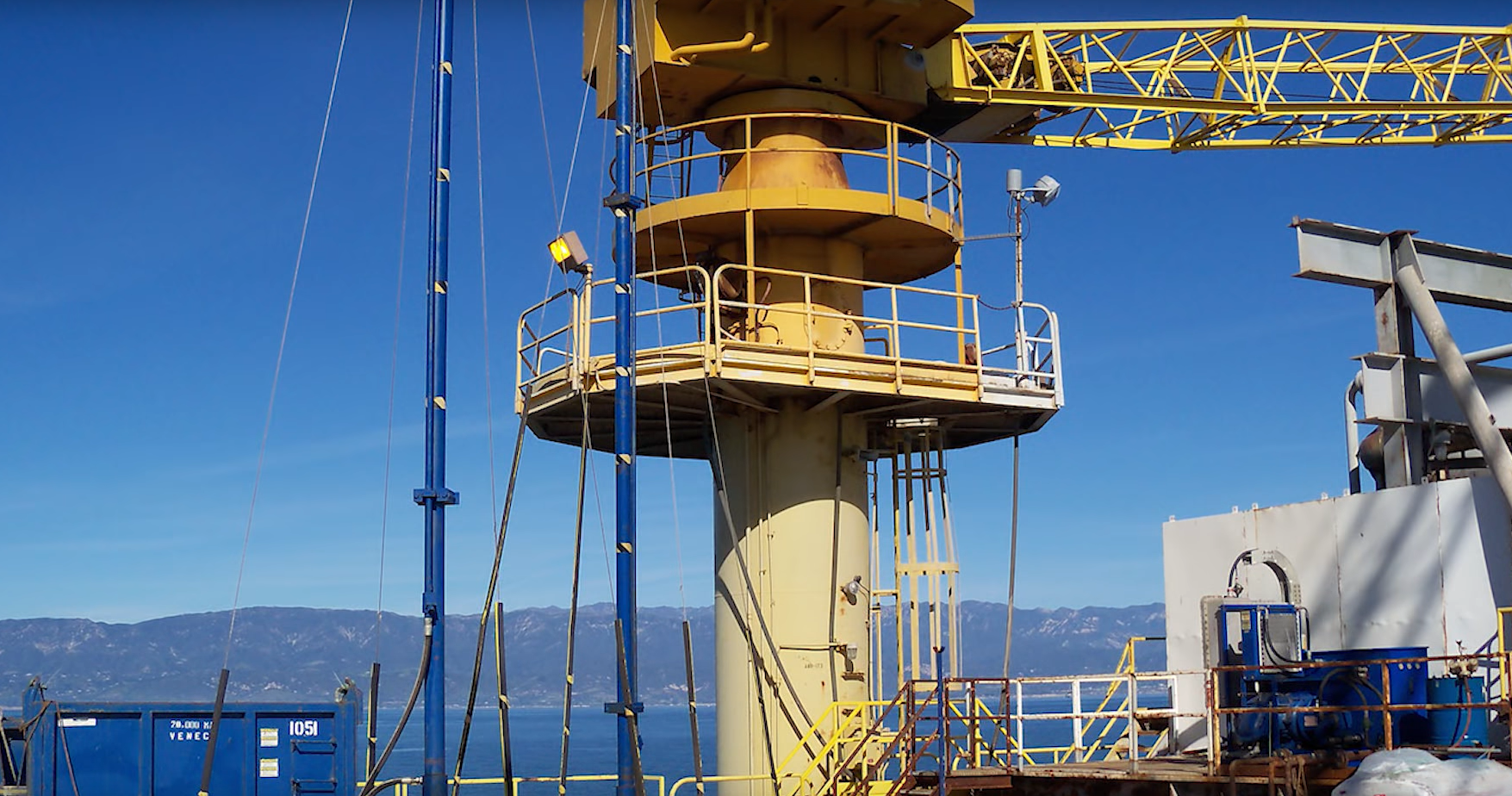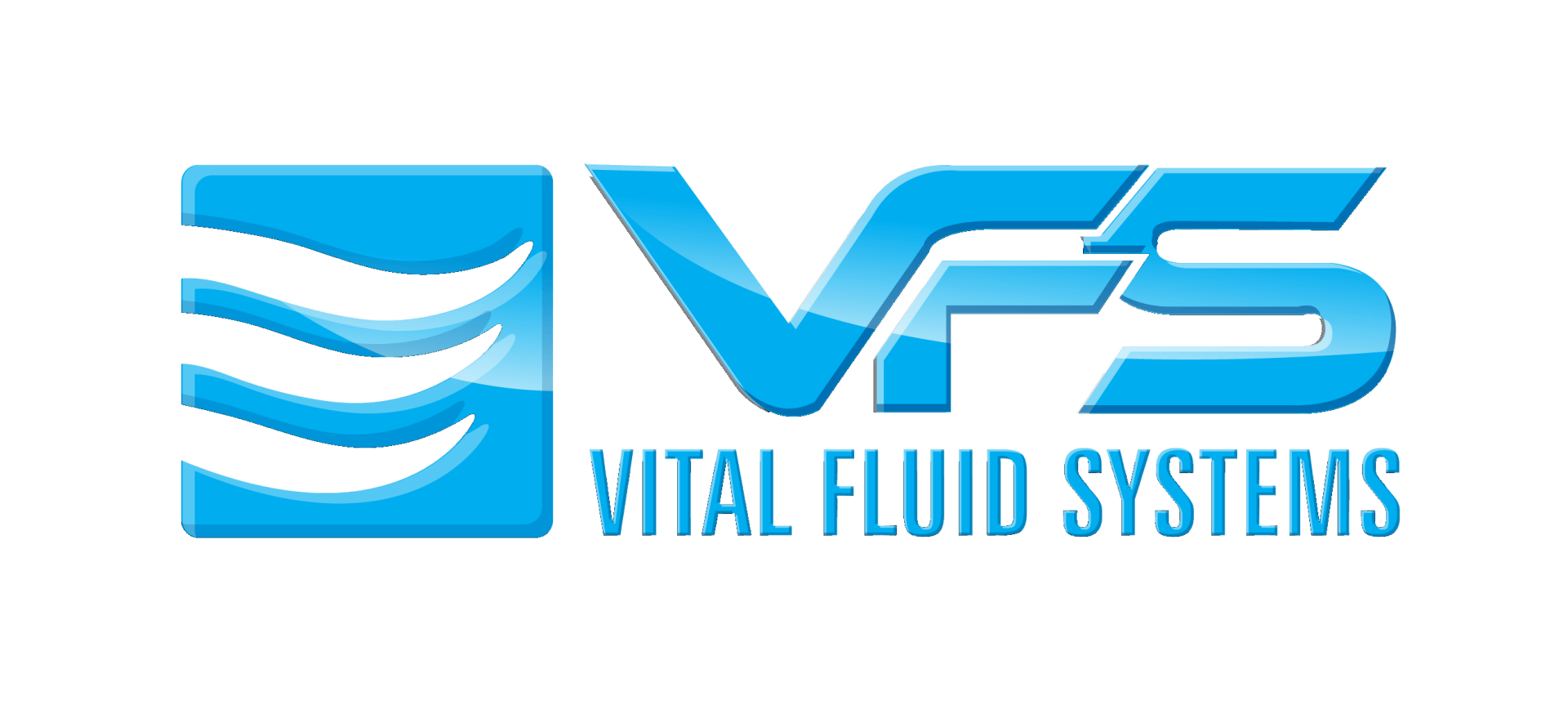
Hydraulic Rod Pumps, Intl. , founded in 1987 in Placentia CA is a world leader in hydraulic rod pumping technology. For over 3 decades, the company had been focusing and developing the world's most durable and advance rod pumping equipment. Their technology & equipment is field proven and had been highly successful in delivering ultra reliable performance for producers worldwide.
Hydraulic rod pumps provide an alternative to traditional beam units, ESP’s, PCP’s, Gas Lift, etc. combining the reliability and durability of a long stroke rod pump with a minimal wellhead footprint. Hydraulic rod pumps are ideal for well production testing, liquid loaded wells & troublesome wells, and deep or deviated wells, in addition to wells where a traditional rod pumps are considered.
The plug & play package comes with the hydraulic cylinder and a hydraulic power unit, well operation is monitored & controlled remotely. Advance controls include pump-off controller, dyno-cards, remote web-based monitoring & control, fluid level monitoring.
Benefits & Advantages of the HRP Hydraulic Rod Pump
Ultra Long Stroke
The long stroking cylinder allows rods to travel at lower speeds, reduced rod string fatigue while its near-fixed traveling speeds resulting in lower rod string compression.
The reduced SPM also reduces traveling/standing valve wear and enables longer tubing life due to longer coupling-to-tubing wear patterns.
The long stroke also provide higher compression ratios, which helps reduce gas locking as well as better mechanical efficiency (stroke vs. stretch ratio).
Ability to lift larger pump plungers = higher volume rate capacities.
Eliminate Stuffing Box Leaks
The HRP cylinder negates the need for a stuffing box and thus eliminate stuffing box leaks typically associated with wear & tear of stuffing box rubbers, or damaged polished rods.
The cylinder has an tried and proven integrated sealing system "stuffing box" that attaches to the bottom of the cylinder, which seats above the flow tee/composite rod lock.
A secondary stuffinx box can be optioned for very dirty fluids and heavy crude. The secondary stuffing box isolate contanimation away from the cylinder and "wipe" the polished rod clean before it enters the cylinder's integral seals.
Low Profile & Compact Package
We manage deliveries from all across the globe to your wellsite. We've been working with trusted and highly professional logistics and freight companies to provide on-time delivery with transparency to the freight schedules.
We'll keep you notified at each step of the delivery status so you know exactly where your equipments are in locally and overseas.
Hazardous Zone Safe
Our trained and experienced engineers will be onsite to provide commissioning services of our equipments and supervise run in hole equipment if needed. We'll be on site to provide recommendations on spacing out the pump, pump stroke testing and more.
We also train field operators to operate the surface equipment including the pump controller and hydraulic power unit. Included in the training is also the maintenance and troubleshooting of equipment we supply.
Advance Pump Controller
We provide end to end support from design to optimisation. Our fully equiped pump shop provides teardown inspections & analysis with a comprehensive report given with recommendations from our partners Black Gold Pump.
We also run monthly lunch & learn sessions and a yearly pump school to keep our customers informed on the latest developments and technology advancement in the rod pumping space.
Specifications
36 to 336 inches
up to 53,376 lbs
10 to 150 HP
5000 psig
150 deg C
60, 100, 200 US Gallons
3000 psig
2.5 to 5.0 inches
Bill of Materials
| Item | Description |
|---|---|
| 1 | Cooling System |
| 2 | Control Panel with Integrated 3G/Wifi Modem |
| 3 | Advance Pump Controller |
| 4 | Prime Mover |
| 5 | Hydraulic Vane Pump |
| 6 | Hydraulic Reservoir with valving system and sensors |
| 7 | Hydraulic Fluid Intake |
| 8 | Hydraulic Cylinder with Piston |
| 9 | Integrated Sealing System |
| 10 | Wellhead Adapter |
| 11 | Intergated Polished Rod |
Long & Slow is the way to go
Rod pump technology has evolved only slightly in the last three decades with one exception: Long stroke and ultra-long stroke HRP pumping units. The necessity to maximize economical efficiencies of rod-pumped oil and gas wells has created a high demand for longer stroke lengths, as most other elements of the rod-pumped well present little room for improvement. The benefits of long and ultra-long stroke pumping units includes increased production rates, reduced bottomhole equipment wear, decreased rod string fatigue, minimized tubing wear in both vertical and directional wells and lower occurrences of bottomhole pump gas locking. These benefits are discussed below in an overview of applied long stroke and ultra-long stroke pumping technology.
Explore below on the benefits of pumping your well long & slow.
Higher Efficiencies with Longer Stroke Lengths
Long stroke and ultra-long stroke HRP pumping units perform with higher pump efficiencies than shorter stroke length units due to the surface stroke length to rod stretch ratio. This advantage applies to the total amount of stretch caused by the load differentials (between minimum and maximum polished rod loads), which occurs as a result of lifting the plunger and the weight of the rod string. Each time the upstroke begins, the rod string stretches before the bottomhole plunger begins to lift fluid, effectively losing some of the gross stroke length (measured at surface).
The rod string then contracts during the downstroke (when the plunger load is absent) and re-stretches with the next upstroke. The amount of this stretch divided into the gross stroke length is the loss of efficiency in a calculated straight percentage. For example, a pumping unit with a 120” stroke length actuates a rod string that stretches 12” each time it upstrokes loses 10% efficiency due to stretch. A comparison using a long stroke unit on the same well follows: A 240” stroke unit lifts the same rod string and plunger (with a longer pump barrel to accommodate the longer stroke). The rod string still stretches 12” every time it upstrokes.
The long stroke pumping unit delivers twice the stroke length (240” at surface). The doubled stroke length now mandates stroking one-half as often to pump the same fluid volume and work (measured in stroke inches per minute). This equates to a 5% efficiency loss, attributable only to rod string stretch. The rod stretch related loss of efficiency becomes increasingly greater on deeper wells, wells with large pump plungers and wells that have rod stretch as a result of rod and tubing friction (such as directional wells).
In summary, the longer stroke pumping unit can deliver 5% more production with the same “inches per minute” traveling speed as the short stroke unit, by spending more time lifting the plunger, as opposed to stretching the rod string.s write about what makes this service unique. If you are using tabs to display restaurant items write about what makes a specific dish particularly worthwhile or delicious.
Reducing Bottomhole Equipment Wear
Referring to the above comparative example, the longer stroke HRP pumping unit was slowed to one-half the number of cycles (strokes) per minute, to produce the same volume as the short stroke pumping unit.
With the well now running at one-half the SPM (strokes per minute), the traveling and standing valves in the bottomhole pump are now cycled only half as often as before. The valves in a bottomhole pump are often the primary cause of pulling jobs due to low pump efficiency, attributable to cyclical wear.
These types of failures are largely relative to the number of cycles, as opposed to the amount of fluid pumped. This is due to the type of valves deployed in pumps, which are subjected to a metal-to-metal impact each and every time the valves close.
By reducing the number of cycles per minute by 50%, the pump life expectancy is theoretically doubled by using the long stroke pumping unit.
Rod compression causes several different problems, one of which is rod fatigue and subsequent premature failure. The second problem is two-fold: Rod and tubing wear. Most cases of rod string compression cause the rods to buckle inside the tubing. This lateral movement creates unnecessary contact between the rods and tubing, which results in tubing and rod wear. Tubing wear is often more prominent (and more costly to repair) because it results in tubing string pressure failures (splits). Rod body wear is often overlooked as an indicator of possible string compression and is usually not properly evaluated during a workover unless extreme wear is present. The worn condition is also commonly dismissed as “acceptable” wear since the lower portion of the rod string is less likely to fail (where rods are not subjected to high stresses). The effects of rod string compression are expensive and unnecessary, and can be greatly reduced when long stroke units are utilized.
Long stroke and ultra-long stroke HRP pumping units reduce rod and tubing wear by two methods. The first is explained above, by reducing acceleration and maximum speeds, and by using a fixed traveling speed. The second is by distributing wear patterns over larger areas (or longer distances). Most rod strings are screwed together with rod couplings. The coupling has a higher profile (larger OD) than the rod body, which forces it to contact the tubing before the body of the rod makes contact. This forces any side loads to be distributed with a high concentration of force on a very small area (the length of the coupling only). This concentrated lateral force travels up and down the tubing only the distance of the stroke length, creating a wear pattern inside the tubing string. The longer the stroke length, the larger the area (or longer linear distance) the wear pattern can be distributed. With a 120” stroke length and rod couplings evenly spaced every 30 feet, the tubing experiences only a 120” long wear pattern from the coupling traveling inside. This leave 240” of un-swept distance in the tubing, or 66.6% of the tubing unworn. A long stroke unit (240”) will effectively distribute the wear over twice the area (distance), leaving only 33.3% of the tubing unworn. This wear pattern enhancement greatly extends the life of the tubing, reducing costly tubing string failures.
Reducing Rod String Fatigue
Despite delivering smooth power to the rod string during reversals, the mechanical beam pumping unit’s sinusoidal acceleration and deceleration causes unwarranted fatigue on the rod string. The acceleration during the beginning of the downstroke on a beam pumping unit often drops the upper portion of the rod string downward faster than the middle or lower rod string will fall, causing rod string compression. This can be caused by a number reasons, including (but not limited to); fluid resistance against the plunger (from fluid viscosity or gas locking), rod friction (caused by lateral side loading of the rods against the tubing), hydraulic resistance of fluid passing around rod couplings and rod guides, or simply attempting to downstroke faster than the rods will fall in fluid.
Conversely, the acceleration during the beginning of the upstroke causes higher than ideal peak stresses on the rod string by quickly accelerating a mass (the rod string). In addition, it has been documented that tremendous peak stresses directly above the pump (at the bottom of the rod string) can also be much greater than predicted and/or expected from the surface when larger bottomhole pump sizes are used. This is caused by resistance against the plunger imposed by fluid friction (attempting to accelerate around rod couplings) during the acceleration phase of the upstroke, and often leads to unexplained or misdiagnosed rod body failures above the pump.
These abnormal loads imposed on the rod string typically manifest themselves in the form of measurable dynamic waveforms, and appear (in graphical form) as a sine wave component within a dynamometer card. It is often referred to as the “rubber-band effect”, as it is based on a rod string’s modulus of elasticity and can be described as a “weight” hanging on rubber-band (where the rod string and plunger comprise the “weight” and the rod string is the rubber-band). The energy created by the abnormal loads repeatedly stretches and contracts (diminishing in magnitude with each cycle) until the energy is dissipated.
Rod string fatigue and subsequent premature failure occurs when the rod string is loaded and unloaded cyclically under abnormal (or extreme) loads. The predicted metallurgical life expectancy of a sucker rod string is based on the absence of compression loads (as well as other detrimental environmental factors) and is theoretically infinite providing safe tension loads are not exceeded (according to the modified Goodman diagram). Whenever abnormal outside forces are introduced (such as compression, corrosion or stress risers), the modified Goodman diagram no longer applies (as the results become unpredictable) and rod string life expectancy is cut drastically shorter. The imposition of abnormal dynamic loads generated by accelerating and decelerating the rod string can drastically decrease the life expectancy of rod strings by exceeding the safe metallurgical load limits under tension (during the upstroke) or compression (during the downstroke). The negative effects of these adverse loads are also magnified when operating in hostile conditions. Varying pump loads (due to fluid level fluctuations), fluid viscosity changes, well bore deviations, sudden speed changes (such as sticking pumps), temperature changes, the presence of corrosives, the fluctuating presence of gas, tubing movement, etc. all serve to adversely affect the metallurgical stability and life expectancy of sucker rods.
Long stroke and ultra-long stroke HRP pumping units were conceived out of a clear understanding of current beam unit and rod string dynamics (and drawbacks), as well as what ideal dynamics for rod and tubing strings should be like. Long stroke hydraulic and mechanical pumping units (such as the Rotoflex) have the same designated purpose: To provide longer, smoother, strokes with linear traveling speeds. Linear traveling speeds drastically reduce the dynamic wave-form load conditions (rubber-band effect) by accelerating to a slower fixed rate and holding a constant rate for the duration of the stroke. This reduces the magnitude of the momentum-reversal-generated energy and allows it to dissipate quickly, drastically reducing rod compression and acceleration-generated higher stresses.if you are using tabs to show different services write about what makes this service unique. If you are using tabs to display restaurant items write about what makes a specific dish particularly worthwhile or delicious.
Reduced Gas Locking Problems
Gas locking occurs when the traveling valve (inside the bottomhole plunger) fails to open to reload the pump, due to the absence (or deficiency) of fluid below the plunger (in the pump barrel). The traveling valve relies on the presence of fluid below the plunger to provide pressure during the downstroke to force the valve open. Wells that produce moderate to high concentrations of gas (or liquids able to form gas under low pressures) are likely to have gas-locking problems.
This includes steam flood, CO2 flood and wells that operate at or near a pumped-off condition. Gas locking can be reduced by spacing the pump plunger close to tapping down with each stroke (a condition where the plunger mechanically hits the bottom of stroke) however, this does not eliminate it or prevent it. The practice of spacing pumps very close to tapping down creates a higher likelihood of damaging either the bottomhole pump, pump shoe (seating ring), standing valve, or standing valve retrieval (on-off) tool. In addition, the practice of tapping a pump down can severely damage to the rod string due to the extreme state of compression.
Spacing a plunger close to tap down is done to reduce the un-swept area below the plunger, effectively increasing the pump’s compression ratio. The compression ratio of a pump dictates how much pressure can be built up below the plunger to assist in opening the traveling valve. Longer strokes and larger pump diameters also increase the pump compression ratios and help to reduce gas-locking problems. Long and ultra-long stroke pumping units help increase well productivity by reducing the frequency and likelihood of gas locking, thereby helping wells remain pumped down longer (reducing annulus back pressure against the formation).
Advance Pump Controller
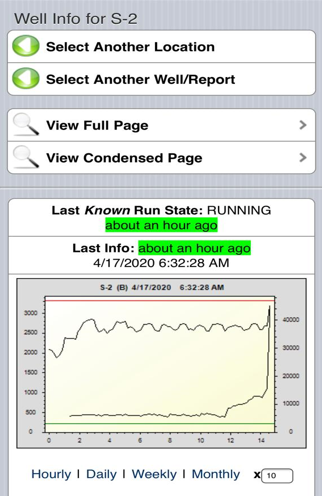
Live & Historical Dynamometer Cards
Dynamometer Cards (Dyno Cards) allow the user to understand and analyse the performance of the downhole equipment. HRP's advance controller provide live Dyno Cards locally and remotely.
You can overlay dynos directly in the web browser with no additional software or plugins to install. Notice the time based dynamometer graph resembles a downhole pump dyno card. In some case, our ability to allow rods to fall faster can be utilized to achieve a greater overall SPM than can be obtained with traditional rod pumps.
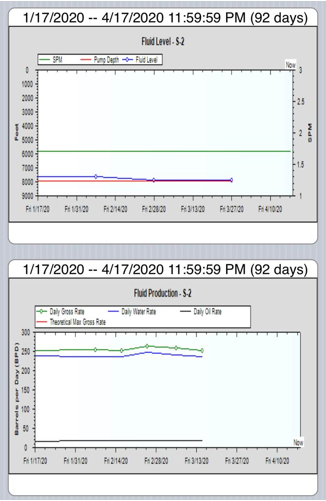
Trend Analysis Graphs
Graphing fluid level, production, and other equipment parameters allows for rapid analysis of conditions affecting current and historical well performance.
Overview reports simplify the process of finding problems or identifying potential candidates for optimization. For example, fluid level decline can be identified before reaching a pumped off condition. The historical strokes per minute and fluid level enable the user to better estimate the optimal SPM to maintain a consistent fluid level.
Likewise, production well test graphs can identify changes in bottom hole conditions and pump efficiencies over time.
Surface equipment data such as polished rod load can be graphed over time to easily indicate changing conditions. Coupled with email and text message alerts, any deviation from historical polished rod load can quickly indicate trouble conditions.
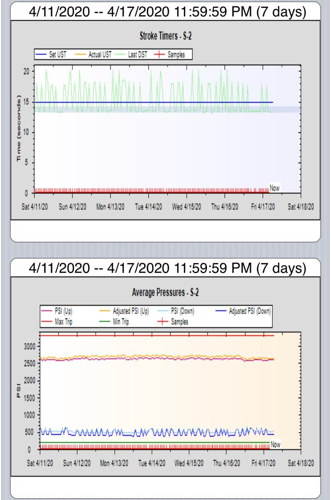
Complete Well History
Fluid levels, production tests, workover history, chemical analysis, rod/tubing diagnostics, surface equipment data, historical comments, and more are all available to the user.
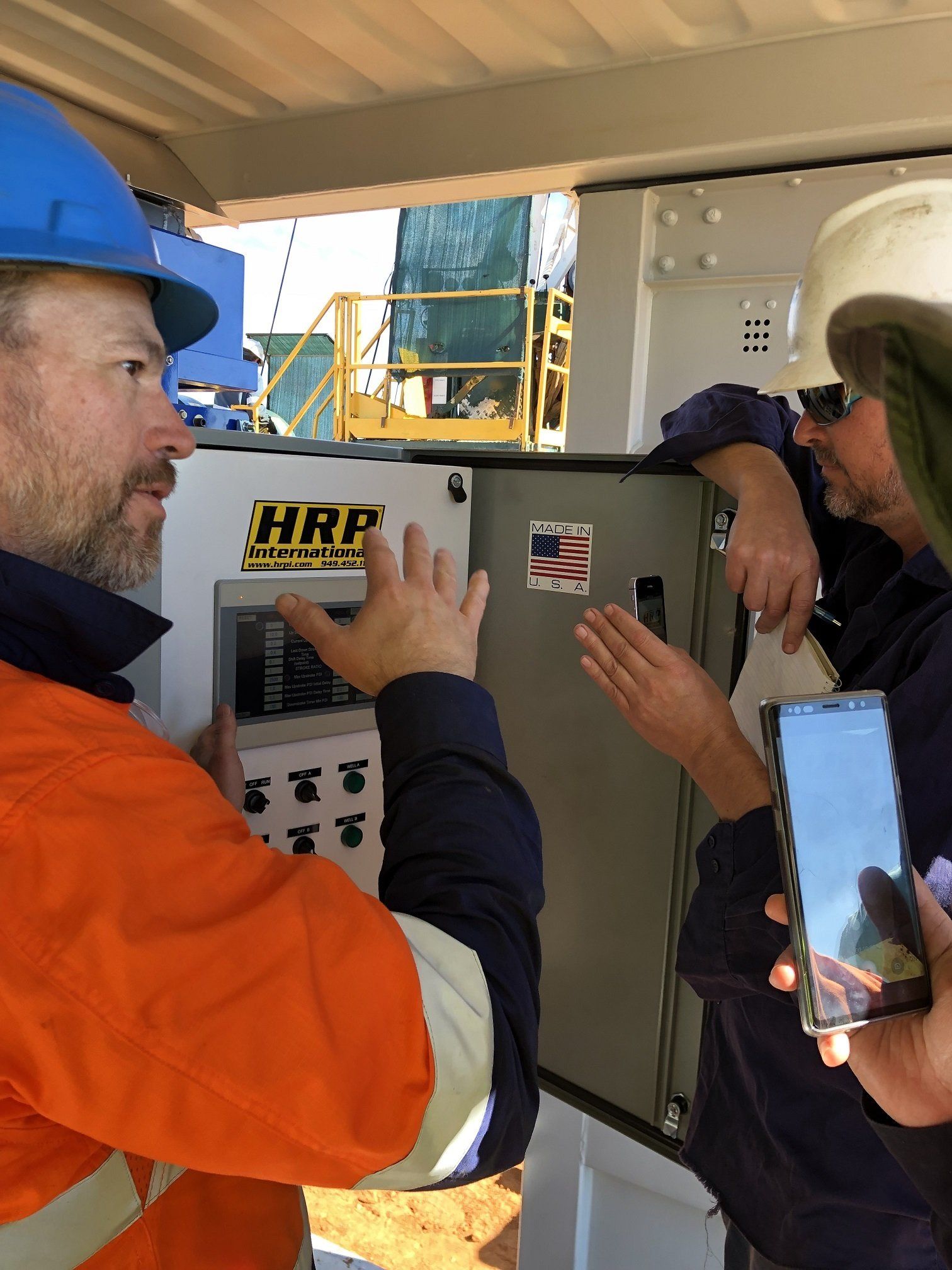
Collaborate Remotely
The web-based interface is ideal for distributing important information to key personnel involved in the design, operation, or maintenance of wells and equipment.
Used in conjunction with teleconferences Operators, Engineers,and Service Providers can collectively troubleshoot or review wells. In addition, well-specific comments are stored on the website to aid in future troubleshooting.
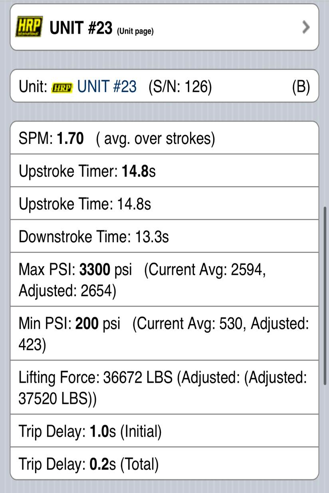
Pump Speed Adjustment
Change speed locally on the intuitive HRP HMI touchscreen on the pump controller or remote via your computer, tablet or phone via a wifi or cellular network.
Speed adjustment is immediate and users will be able to monitor the SPM real time.

Email & Test Alerts
Customizable alerts provide notification of potential trouble conditions direct to your cell phone. Trouble conditions can then be addressed proactively. Alerts can be delivered as they occur, or can provide summary information.
From these automated alerts, a single person can monitor multiple locations.
Fluid Level vs Pump Speed
HRP Installation Gallery
MENU
CONTACT US
Office, Pump Shop & Warehouse
Unit 4, 37-39 Devlan StreetMansfield 4122 QLD
Phone +61 7 3062 9475Fax +61 7 3252 7752
sales@vitalfluidsystems.com.au
STAY CONNECTED
Join our newsletter and find out more
Contact Us
We will get back to you as soon as possible
Please try again later

